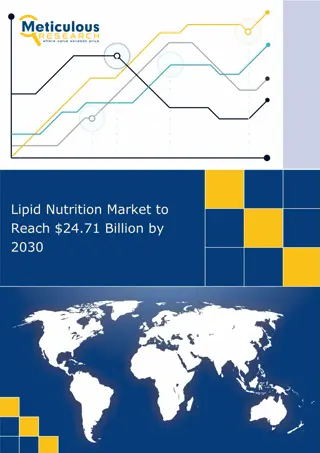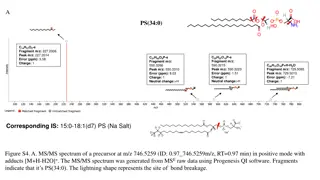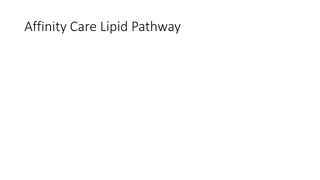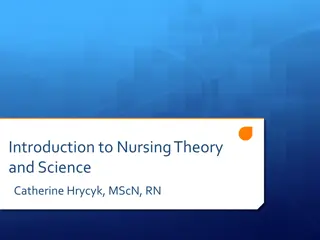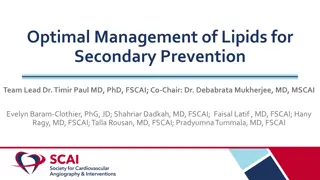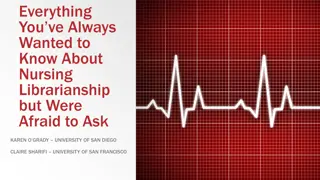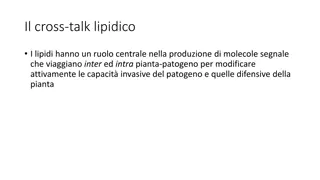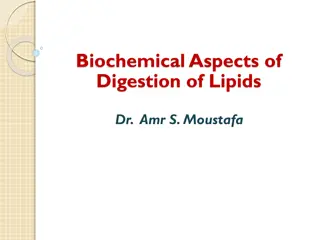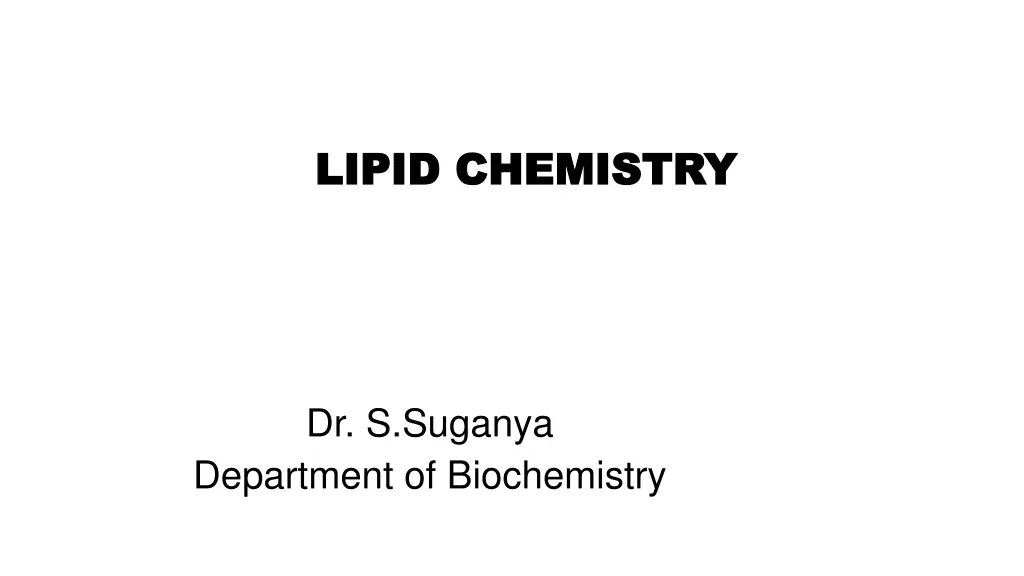
Understanding Lipid Chemistry in Biochemistry
Explore the diverse world of lipids in biochemistry, including their definition, functions, and classifications such as simple lipids, compound lipids, and phospholipids. Learn about triglycerides, waxes, phospholipids, glycerophospholipids, and more, and how they play crucial roles in energy storage, membrane structure, and metabolic regulation in living organisms.
Download Presentation

Please find below an Image/Link to download the presentation.
The content on the website is provided AS IS for your information and personal use only. It may not be sold, licensed, or shared on other websites without obtaining consent from the author. If you encounter any issues during the download, it is possible that the publisher has removed the file from their server.
You are allowed to download the files provided on this website for personal or commercial use, subject to the condition that they are used lawfully. All files are the property of their respective owners.
The content on the website is provided AS IS for your information and personal use only. It may not be sold, licensed, or shared on other websites without obtaining consent from the author.
E N D
Presentation Transcript
LIPID CHEMISTRY LIPID CHEMISTRY Dr. S.Suganya Department of Biochemistry
Definition Heterogenous group of compounds insoluble in water,soluble in organic solvents like chloroform, ether and benzene They are esters of fatty acids with alcohol and are utilized by living organisms
BMI Storage form of energy (Triglycerides) Structural component of biomembranes (Phospholipids and Cholesterol) Metabolic regulators (Steroid hormones and prostaglandins) Act as surfactants, detergents and emulsifying agents (Amphipathic lipids) Act as electric insulators in neurons Help in the absorption of fat soluble vitamins
Phospholipids Glycolipids Lipoprotein
Definition Simple lipids: - esters of fatty acid with various alcohols. Compound lipids: - esters of fatty acid with alcohol containing additional groups Derived lipids - products obtained after the hydrolysis of simple or compound lipids
Simple lipid TAG triacylglycerol - ester of fatty acid with alcohol glycerol - they are uncharged and termed as neutral fat - fat we eat mostly are TG
Waxes - esters of fatty acid with HMW monohydric long chain alcohol Eg. Bees wax, spermaceti oil
Compound lipid 1.Phospholipid 2.Glycolipid 3.lipoprotein
Phospholipid Lipids containing in addition to fatty acid and an alcohol, a PHOSPHORIC ACID residue Classified into 1.Glycerophospholipid 2.Sphingophospholipid
Glycerophospholipid Alcohol present is glycerol 1. Phosphatidyl choline 2. Phosphatidyl ethanolamine 3. Phosphatidyl serine 4. Phosphatidyl inositol 5. Lysophospholipid 6. Plasmalogens 7. Cardiolipins
Sphingophospholipids Alcohol present is sphingosine 1.Sphingomyelins
Glycolipids Fatty acid , alcohol sphingosine with CHO with nitrogen base No phosphate group 1.Cerebrosides 2.Gangliosides
Functions Major lipid of cell membrane Regulate the permeability of membrane Regulate activation of some membrane bound enzyme Acts as lipotropic factor Good emulsifying agent
Lipoproteins Combination of lipid with prosthetic group protein 1.Chylomicrons 2.VLDL 3.LDL 4.HDL
Functions Chylomicron transport dietary lipid from intestine to peripheral tissues VLDL transport of TAG from liver to peripheral tissues LDL transport of cholesterol from liver to peripheral tissues HDL transport of free cholesterol from peripheral tissues to liver
Derived lipids Products obtained after hydrolysis of simple and compound lipid 1.Fatty acid 2.Steroids 3.Cholesterol 4.Lipid soluble vitamins 5.Ketone bodies
Fatty acid Carboxylic acid with hydrocarbon chains
R stands for hydrocarbon chain Amphipathic in nature`
Classification of fatty acid 1.Straight chain fatty acid 2.Branched chain fatty acid 3.Substituted fatty acid 4.Cyclic fatty acid
Straight chain fatty acid Fatty acid with carbons arranged linearly 1.Saturated fatty acid (no double bond) 2.Unsaturated fatty acid ( contain double bond)
Branched chain fatty acid Less abundant than straight chain fatty acid 1.Isovaleric acid 2.Isobutyric acid
Substituted fatty acid One or more hydrogen bond is replaced by another group 1.Lactic acid of blood 2.Cerebronic acid of brain glycolipid 3.Ricinoleic acid of castor oil
Cyclic fatty acid Bearing cyclic group presentation in some bacteria and seed lipids 1.Hydnocarpic acid
Function of fatty acid Serve as building block of phospholipid and glycolipid Derivatives serve as hormones Serve as major fuel for most cells
Numbering of fatty acid Starting from COOH terminal Carbon 2 and 3 referred as alpha and beta CH3 is at distal end and called as omega carbon
Essential fatty acid Required for optimal health and cannot synthesized by body and should be supplemented in the diet Linoleic acid; linolenic acid Arachidonic acid can be synthesized from linoleic acid
Function Synthesis of Eicosanoids Maintains of structural integrity Development of Retina and Brain Skin protector Antiatherogenic effect
Deficiency 1.Scaly skin 2.Eczema 3.Loss of hair 4.Poor wound healing
Reaction of lipids Saponification Hydrogenation Peroxidation rancidity
TAG Esters of fatty acid with glycerol TAG consists of 3 FA which is esterified through their carboxyl group resulting in loss of negative charge Hence uncharged and named as neutral fat
Types Simple TAG- same FA in all 3 position Mixed TAG two or more different FA -C1 saturated -C2 unsaturated -C3 either of the two
Cholesterol Major sterol in animal tissues 19 carbon atoms steroid nucleus phenathrene Methyl side chain at C10 and C13 position 27 carbon compound, 8 carbon side chain attached to D ring at C17, hydroxyl group attached to C3 with one double bond b/w C5 and C6
Functions Major structural constituent of cell membrane Serves as precursor of 1. Steroid hormones 2. Bile acids 3. Vitamin D
Eicosanoids They are 20 C compounds derived from arachidonic acid
Eicosanoids Prostinoids Leukotrienes lipoxins
Prostagladins Derive their name from the tissue in which they were 1strecognized but they are now almost present in all tissues Parent compound is prostanoic acid Act as local hormones Contains a five carbon ring -OH group is present at C15 Prostaglandins PGD2, PGE2, PGF2, PGI2 and TXA2
Functions Causes vasodilatation and inhibits platelet aggregation Causes vasoconstriction and Platelet aggregation Medical termination of pregnancy Bronchodilator Inhibits gastric secretion can be used for treatment of acid peptic diseases
Thromboxanes Isolated from blood platelets, thrombocytes- hence the name Six membered oxane ring
Functions Abbreviated as Tx TxA2 produced by platelets promotes platelet aggregation Causes TxA2 smooth muscle contraction
Leukotrines Conjugated trienes 5 sub classes(A to E)
Functions Facilitate chemotaxis, inflammation, allergic reaction




